org
Design against Corruption
Let’s say the president of your country is corrupt. Let’s just say.
 The legislature is corrupt. The court system, police, and military are all corrupt. The city officials? The big businesses? They’re corrupt, too.
The legislature is corrupt. The court system, police, and military are all corrupt. The city officials? The big businesses? They’re corrupt, too.
They misuse their power. They thrive on favoritism and get rich on kickbacks while the rest the country slowly starves. What do you do?
Replacing one individual with another doesn’t change the broader system or take away any of the incentives for corruption.
So how do you reduce corruption throughout a given system?
Transparency International is a network of independent national chapters that work to curb “both the supply and demand of corruption.”
Some of the strategies they use are described in their annual Corruption Fighters’ Tool Kit. The manual is just one of the ways the TI chapters share ideas with each other and offer their experience to the world at large. In addition to the hard work of organizing and building coalitions, many of the corruption-reducing strategies incorporate graphic and interactive design. Some of them include:
- Awareness Raising - TI Korea produced posters, videos, and CD-ROMs to disseminate information about the effects of corruption and local initiatives against it. TI Morocco indexed, cataloged, and analyzed incidents of corruption that appeared in the media, published their findings and will soon make this database accessible online. As part of its campaign to promote access to information in Romania and the Federal Republic of Yugoslavia, TI Romania produced and actively updated a Web site on the issue, printed a pocket guide to inform citizens about their rights, and designed posters and flyers with their Serbian partner organization to promote the idea of free access to public information and raise public awareness about the project. The posters were printed in Romanian and Serbian and distributed through an international network of NGOs and local government offices.
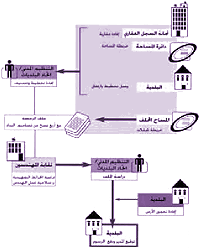 Monitoring Election Campaigns - TI Chile developed and distributed a report card to tabulate the quantity, subject, and context of media coverage devoted to each candidate. They distributed their analysis and data on CD-ROM.
Monitoring Election Campaigns - TI Chile developed and distributed a report card to tabulate the quantity, subject, and context of media coverage devoted to each candidate. They distributed their analysis and data on CD-ROM.- Opening Processes - Activists in Lebanon determined that construction was the most corrupt sector in the country and designed a manual on how to acquire a construction permit, “one of the most difficult bureaucratic transactions in the Lebanese administration.” In response to the government’s lack of reliable information on the process of public procurement, TI Ecuador created an Web site to inform the public (and the private sector), make government forms available, display past and current bidding processes, and host a forum for discussion and analysis.
- Implementing Diagnostics - TI chapters in Bangladesh, Kenya, and Japan developed surveys and metrics for corruption in government and the private sector that they then published locally. TI Lithuania created a database of institutional and geographic aspects of corruption and published a “Map of Corruption” as a foundation for future campaign work.
Fed Up with The Front
Since 1991, Ras l’front (“Fed up with the Front”) has campaigned against Jean-Marie Le Pen and his extreme right-wing party, the National Front. Ras l’Front collectives are active in cities throughout France.
See this collection of their posters on racism, fascism, sexism, immigrant rights, and other issues.
Bronx Community Paper Company
In the Internet Archive, the javascript ticker still scrolls “Recycling Community Improvement Water Conservation Job Creation Economic Development Brownfield Reclamation,” beneath the former Web site:
“The Bronx Community Paper Company (BCPC) — a joint project of the Bronx-based Banana Kelly Community Improvement Association and the Natural Resources Defense Council is an innovative effort to harness New York City’s ‘urban forest,’ which includes the 1.2 million tons of paper the city throws out every year, by building a paper de-inking and newsprint production facility in the city....
The end result will achieve several important objectives: creation of hundreds of long-term jobs; reduction of the City of New York’s costs for disposing of wastepaper; revitalization of an abandoned industrial tract in the inner city; and protection of forests....
Throughout the development process, the BCPC kept the public continually informed on the project’s progress. In fact, during the environmental licensing process, the BCPC held over 120 public meetings with members of the South Bronx community, although by law a developer is only required to hold one...
 With all legal, political and environmental issues behind them, only two major tasks for the BCPC remain — securing a deal with a paper company to operate the plant, and, of course, building the mill.”
With all legal, political and environmental issues behind them, only two major tasks for the BCPC remain — securing a deal with a paper company to operate the plant, and, of course, building the mill.”
Facilities for the BCPC were to be built on the Harlem River Rail Yard, a brownfield site requiring environmental remediation. The mill was to produce 2,200 jobs during construction and more than 600 permanent full-time jobs during operation.
In 1997, the Department of Energy posted a glowing review of the project as a “sustainable business success story”:
- The manufacturing facility will be an integrated recycling paper mill, including a wastepaper de-inking plant, a newsprint paper making machine, a wastepaper sorting plant and a steam boiler.
- The project will advance the market for economically viable recycling of 100% post-consumer, totally chlorine-free paper.
- The mill will serve as a solid waste alternative for a city recently proposing to build seven large waste incinerators.
- The paper mill will enable a major paper-making company to use secondary fibers for the manufacture of its newsprint, a commodity that is now manufactured mostly with virgin timber.
- The Harlem Rail Yard, an abandoned industrial facility in an out-of-use rail yard, will serve as the site of the mill. An additional goal of the project is to redevelop the rails, which will then serve as a transportation corridor for materials to and from the facility.
- The project will pioneer the use of water from a reclaimed sewage wastewater treatment plant, keeping water costs one-third lower than comparable fresh water.
- A comprehensive air study of the South Bronx was initiated to ensure technologies will be implemented to reduce to the greatest extent possible all emissions from the facility.
- The project will incorporate innovative energy-efficient technologies not implemented in any other paper mill in the country.
- The mill will utilize a chlorine-free de-inking technology that produces no air emissions or odors.
- Maya Lin, designer of the National Vietnam Memorial in Washington, DC, will design the facility’s layout and structure.
Banana Kelly was founded in 1977 when thirty residents gathered to stop the demolition of their homes along Kelly Street, a crescent shaped block in the heart of the Longwood/Hunts Point neighborhood of the South Bronx. Without support, tools, money, title to the property, they succeeded in rehabilitating the buildings and in creating 21 units of high-quality affordable housing. The activists formed the Banana Kelly Community Improvement Association, Inc. to continue the work that they had started. Since 1978, the organization has rehabilitated, weatherized, and managed thousands of housing units, provided service referral and housing advocacy, conducted education and job training, and attracted the first new health care clinic in the community in 22 years.
Revenue from the Bronx Community Paper Company was to fund other community development projects in the neighborhood, including:
- The Bronx Dormitory Project. A joint venture between Banana Kelly and Bronx Regional High School that will provide shelter for up to 20 students attending the high school who do not have stable living arrangements.
- The South Bronx Family Learning Center. A proposed 35,000-square-foot center that will include health care, child care, literacy classes, employment and training centers and housing opportunities.
- The Prospect Corridor Commercial Development Project. This project will promote local economic development by connecting existing and planned residences with a retail strip on Prospect Avenue.
- The Library Project. A project to increase the availability of library services in the South Bronx by providing additional equipment, supplies and materials to local libraries.
- Business and Housing Revolving Loan Fund. This project will provide a pool of working capital to be used by small entrepreneurs to purchase inventory, equipment or supplies to meet their contractual obligations and expansion needs. The fund will concentrate its services on housing groups that require basic repairs or replacement of major systems in their buildings.
- The Children’s Endowment Fund. To be administered by Banana Kelly, this fund will enhance and expand the educational and vocational opportunities available to children.
But by 2000 the project had folded.
From The New York Times, August 17, 2003
‘Bronx Ecology’: Green, Rocky Road
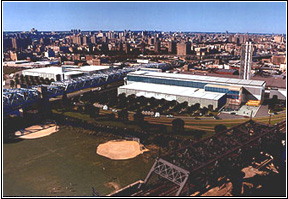 “In 1992, Allen Hershkowitz, a senior scientist with the Natural Resources Defense Council, proposed building a paper mill in the South Bronx. It would harvest the immense amount of wastepaper (used newspapers, junk mail, office detritus) New York City generates each day, recycle it into newsprint using ecologically sound methods and sell the product to local consumers, notably newspapers. Such a mill would address two city woes: the continuing slump, particularly severe in places — like the South Bronx — long dependent on the shrinking manufacturing sector (joblessness there hovered around 20 percent, 50 percent for teenagers); and the loss of traditional outlets for the city’s waste stream (ocean dumping, hauling to putrid landfills and burning in dioxin-spewing plants).
“In 1992, Allen Hershkowitz, a senior scientist with the Natural Resources Defense Council, proposed building a paper mill in the South Bronx. It would harvest the immense amount of wastepaper (used newspapers, junk mail, office detritus) New York City generates each day, recycle it into newsprint using ecologically sound methods and sell the product to local consumers, notably newspapers. Such a mill would address two city woes: the continuing slump, particularly severe in places — like the South Bronx — long dependent on the shrinking manufacturing sector (joblessness there hovered around 20 percent, 50 percent for teenagers); and the loss of traditional outlets for the city’s waste stream (ocean dumping, hauling to putrid landfills and burning in dioxin-spewing plants).
More grandly, Hershkowitz’s Bronx Community Paper Company would serve as a world-class demonstration project. He wanted to prove the viability of green capitalism — a marriage of economic development and environmental remediation+- to a host of unbelievers in the business world and the environmental movement, who were locked (he believed) in unnecessary combat. Hershkowitz knew the city presented a host of special obstacles to eco-industrialists, but if a mill like this could make it here, he reasoned, it could make it anywhere. He came amazingly close to pulling it off, as ‘Bronx Ecology,’ by Hershkowitz himself, and ‘Tilting at Mills,’ by Lis Harris, for many years a staff writer at The New Yorker, show.
To guarantee good relations with the plant’s neighbors, Hershkowitz found a local sponsor in Banana Kelly, one of the community development corporations that had sprung up in the 70’s, and vested ownership in it. Determined to resuscitate urban brownfields (polluted and abandoned industrial sites), the paper company settled on the derelict Harlem River Rail Yard. And to transform what others saw as waste into valuable raw material — a key precept of the sustainable economy movement — he insisted the mill use recycled water from a nearby sewage treatment plant instead of river water.
Hershkowitz found a receptive Swedish paper company, and with a corporate anchor secured, investment bankers came on board, as did construction companies and engineers. He got Maya Lin, the architect of the Vietnam Veterans Memorial, to design a striking complex. The Natural Resources Defense Council put up seed money and helped clear regulatory hurdles. A bevy of foundations gave predevelopment grants. The state offered loan guarantees and helped with cleanup costs, and the city’s economic development arm provided expertise. On paper, it looked like a half-billion dollar enterprise was taking off.
Almost immediately it slammed into problems.
Businessmen’s support proved fickle: from their perspective Hershkowitz had overburdened the project with costly, time-consuming and risky furbelows on behalf of extraneous, if not alien, social and ecological goals. Worse, when the Swedish firm withdrew (new management wanted to concentrate on European ventures) it proved impossible to find another big paper company, the kind Wall Street would approve (one potential replacement declined after calculating it could clear more than 30 percent in the Bronx, but 40 percent in South Korea). Besides, in the 90’s boom, higher profits were available outside the industry altogether, in tech stocks or hedge funds. After 1992, moreover, the supply of newsprint outran demand, so producers began consolidating; the last thing they wanted was a new plant online.
And there were local competitors. In 1995, an Australian company built a recycling mill on Staten Island and won the right to process up to 50 percent of the city’s wastepaper. Though not in direct competition — it produced liner board (used, for example, for shoe boxes), not newsprint — it lobbied hard against any municipal deal with Hershkowitz, just in case one day it might want the remainder. Also opposing the Bronx project were commercial carters linked to the mob, and waste haulers whose profits were linked to exporting the trash, including giant multinational corporations like Waste Management , whose campaign contributions gave them considerable clout at City Hall. Mayor Rudolph Giuliani was already predisposed against the project because the Bronx was the domain of a rival, Fernando Ferrer, though in fact Ferrer too was an opponent, miffed he hadn’t been allowed to pick the participating community groups.
Some of Hershkowitz’s biggest headaches came from his presumed community ally, whose new leadership proved undependable. Other community groups were also on the attack, some because the building trades refused to give construction jobs to neighborhood people, others because they wanted a slice of the development pie. (Once he was told that $70,000 would make his problems go away; when he refused to come across, Hershkowitz says, it was publicly implied that the plant was environmentally genocidal.)
Despite all this, Hershkowitz and the project plowed on, year after year, nimbly escaping one crisis only to tumble into another. Finally, just after having found a large construction company willing to undertake the project, the backers were sued by a rival construction firm (a common way to grab a piece of the action). Now the Natural Resources Defense Council itself wanted out, and its employee off the case. The paper company was handed over to the contractor-developer in 1999 and struggled on one more year before Giuliani pulled the plug....
The real question is how useful his blueprint for a greener future really is. Here, it seems to me, Hershkowitz pulls back from confronting the implications of what he’s laid out, particularly the key question of who exactly might be the agent to make his vision real. It’s clearly not the corporate world: ‘green capitalism’ stands revealed as a patent oxymoron. He urges environmentalists to step forward, but there’s no sign that major environmental groups will soon venture again into eco-industrial waters (certainly not if they read ‘Bronx Ecology’). As for labor, union pension fund managers proved even more conservative than investment bankers.
Hershkowitz comes closest to the mark when he wonders if the state might not expand its role, either building green projects as public works or committing public capital as lead investor. Certainly — pace current free-market pieties — government is capable of ambitious enterprise, viz. the Manhattan Project, the the space program, the Internet and the New Deal. Moreover, putatively private industries (notably pulp and paper, petroleum and highway construction) are, Hershkowitz reminds us, heavily subsidized by various levels of government. Why not be transparent about public investment, and establish a federal development bank like, but better than, the Reconstruction Finance Corporation that underwrote much of the New Deal and World War II? That might yet make Hershkowitz’s bold blueprint a reality.”
The Bronx Community Paper Company may be dead for now, but near by, in Hunt’s Point, a plastics recycling plant is just being planned.
Gaviotas

In 1965 Paulo Lugari was flying over the impoverished Llanos Orientales, the “eastern plains” that border Venezuela. The soil of the Llanos is tough and acidic, some of the worst in Colombia. Lugari mused that if people could live here they could live anywhere.
The following year Lugari and a group of scientists, artists, agronomists and engineers took the 15-hour journey along a tortuous route from Bogota to the Llanos Orientales to settle. The local population, including the indigenous Guahibo people, familiar with the political terror and violence of the ‘white man,’ were naturally suspicious.
Nearly 40 years later, while war rages across Colombia with the help of U.S. funds, equipment, and training, the 200 residents of Gaviotas, including farmers, scientists, artists, and former street kids, have created a thriving village and environmental research center in Vichada in Los Llanos.
“Gaviotas is named after a bird that enlivens the rivers at dusk.” [source]
“They have planted millions of trees, thus regenerating an indigenous rainforest. They farm organically and use wind and solar power. Every family enjoys free housing, community meals, and schooling. There are no weapons, no police, no jail. There is no mayor.” [source]
“Gaviotas provided a chance to plan a tropical civilization from the ground up, instead of depending on technologies developed for northern climates. ‘When we import solutions from the US or Europe,’ said Lugari, founder of Gaviotas, ‘we also import their problems.’
Over the years Gaviotas technicians have installed thousands of the windmills across Colombia - in some places gaviotas is the local word for windmill.”
Around 58 types of windmill were tried and tested before the pioneers came up with determined that the distinctive ‘sunflower’ design functioned best in the plains.
 “Since Gaviotas refuses to patent inventions, preferring to share them freely, the design has been copied from Central America to Chile.
“Since Gaviotas refuses to patent inventions, preferring to share them freely, the design has been copied from Central America to Chile.
Electricity comes from a low-head turbine powered by a stream, except in the short dry season, when it is backed up by a diesel generator. ‘In 24 years we’ve learned to cover 70 percent of our food and energy needs,’ says Gonalo Bernal, administrator of Gaviotas. ‘The trees we plant more than compensate for any greenhouse gases we emit. Imagine if the rest of the world lived like us.’
Gaviotas began as a collection of researchers, students, and laborers sharing vehicles, bedding, dishes, clothes - and decisions. In time several of their families joined them and a permanent colony with individual houses emerged. Government was by consensus and unwritten rules. To limit public disorder, alcohol is confined to homes. To preserve wildlife, dogs and guns are banished. A need for police, jail, or door locks has never arisen. Anyone who violates protocol, like a storekeeper who recently admitted to overcharging, is ostracized by the community until his debt is paid. Loafers aren’t tolerated, but with wages above the Colombian minimum wage, plus free meals, medical care, schools, and housing, loafing isn’t a problem.
A techno-tour of the llanos shows how Gaviotas has revolutionized life here. The most significant invention is a simple hand pump capable of tapping aquifers six times deeper than conventional models, but requiring so little effort that children can operate it. In normal pumps a heavy piston must be raised and lowered inside a pipe. Gaviotas engineers realized they could do the reverse; leave the piston stationary and lift an outer sleeve of lightweight, inexpensive PVC tubing instead.”
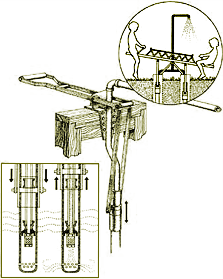 “In the open-air Gaviotas preschool, the children’s see-saw is actually a pump in disguise. As they rise and descend, water gushes from a vertical pipe into an open cement tank. Over the years Gaviotas technicians have installed these in thousands of school yards, using kid power to provide villages with clean water. This simple, inexpensive pump has revolutionised rural life across Colombia for people who used to haul their water in buckets from muddy tropical rivers.” [source]
“In the open-air Gaviotas preschool, the children’s see-saw is actually a pump in disguise. As they rise and descend, water gushes from a vertical pipe into an open cement tank. Over the years Gaviotas technicians have installed these in thousands of school yards, using kid power to provide villages with clean water. This simple, inexpensive pump has revolutionised rural life across Colombia for people who used to haul their water in buckets from muddy tropical rivers.” [source]
“At a windmill-fed cattle trough, surrounded by a sloping cement floor, cowboys have just brought several thirsty calves. As they drink, their dung slides down the slope into a gutter, which sluices it to an enclosed anaerobic fermentation tank, where the cow-pie slurry turns into compost and methane.
The methane flows through pipes to the 16-bed Gaviotas hospital, which a Japanese architectural journal has named one of the 40 most important buildings in the world. It is at once both futuristic and ancient, a maze of angles formed by white walls, glass awnings, skylights, brushed steel columns, and exposed supports trimmed in blue and yellow enamel. The interior is cooled with underground ducts whose hillside intakes face the prevailing breeze. Opposing layers of corrugated roofing create a series of air channels that further bleed away the heat. The combined effect is cost-free, maintenance-free air conditioning. Solar collectors on the roof alternately heat, boil, and distill water. Electricity is from solar photovoltaic cells.
The only hospital within a 12-hour radius, it serves all comers, including both guerrilla and army forces battling in the area. ‘The rule here is never to ask,’ says Bernal. ‘Like the Red Cross, everybody respects us.’
A short, vine-covered walkway connects the Gaviotas hospital to the maloks, a separate wing built by the local Guahivo Indians. Instead of beds, patients and their families lie in hammocks hung from wooden beams under a great thatch roof. Relatives of the sick tend crops of tomatoes, lettuce, and onions in an adjacent hydroponic greenhouse.
If the National University’s pharmacology department and the Guahivo shamans have their way, this greenhouse will one day become the finest medical plant laboratory in the tropics. But money is a critical factor, and Colombia’s expanding, government-owned oil and gas industry has dampened Gaviotas’ solar collector sales by blocking tax benefits for investing in alternative energy. At  the same time revenue from windmills and pumps dropped as Colombian agriculture was battered by an unexpected onslaught of cheap imported foods, the fallout of new free trade policies.
the same time revenue from windmills and pumps dropped as Colombian agriculture was battered by an unexpected onslaught of cheap imported foods, the fallout of new free trade policies.
So Gaviotas has decided to scale down its manufacturing. But no one is getting laid off. ‘Gaviotas isn’t a company,’ Lugari says, ‘we’re a community. In fact the solution means that both employment and Gaviotas will grow.’
The solution is the nearly 20,000 forested acres. In the past 12 years, Gaviotas has planted 1.6 million Caribbean pines (after finding that no indigenous tree would grow on the prairie). To the surprise of foresters, Gaviotans chose not to cut their standing timber. Instead they are converting their windmill factory to process pine resin. Colombia spends $4 million annually to import such resins for the manufacture of paint, turpentine, and paper. Armed with that fact, Lugari persuaded the Japanese government to provide the seed money, via a grant through the Interamerican Development Bank, to begin tapping and processing resin for the domestic market.” [source]
Since the above was written in 1995, the community no longer purhcases diesel fuel and is now totally energy independent. They generate power with turbine engines fueled by the resin of the Carribean pine trees in their forest. These pines are being slowly crowded out by the regeneration of indigenous rainforest. [source]
Other inventions include:
- a high pressure solar cooker
- methane burners
- hot-water solar panels
- parabolic solar grain driers
- self-cooling rooftops
- cooling wind corridors
- corkscrewing manual well digger
- variety of highly efficient and durable windmills
- specialized bicycle for the Llanos
- pedal powered cassava grinder (10 hours work done in 1 hour)
- rotating drum peanut sheller
- ox-drawn land graders
- one-handed sugarcane press
Gaviotas engineers also designed a solar kettle for the hospital. According to engineer Jaime Dávila, “the principle begins with an old country custom: boil water one day to drink the next, after it cools.” Dávila’s goal was an inexpensive solar-operated system that would give unlimited boiled drinking water, already cooled to room temperature, straight from a tap any time of day, and would work under cloudy skies. The kettle took six years to perfect. It combines solar panels, storage tanks, an efficient heat exchanger, a bit of distillation and a spigot — which you turn to draw off potable water.[source]
See some renderings of their solar collectors, solar oven, and wind-powered musical organ.
ISO 14001 Reconsidered
Reader Desmond B. writes:
“Browsing through your site, I was interested by your relatively neutral presentation of the ISO programme. You presented some interesting aspects of the bureaucratic inanities, as well as some of the difficulties of applying euro-centric standards (the symbology not being applicable worldwide) on a global scale. It seems as though there are many positive aspects to the ISO programme (your mention of Toyota’s practices), it appears that there is relatively little citizen/democratic control or oversight of this organisation. It’s one thing to standardise container sizes, but environmental management procedures should perhaps be a more public affair. Curious to see some critical comment from you regarding this, especially considering the frequent mentions of ISO on your site.”
True enough. In my two posts that mention the ISO I was fairly neutral. I was less concerned about democratic accountability of the ISO because the standard setting process is fairly open and decentralized, and standards compliance is entirely voluntary. It is up to governments, not the ISO, to legislate, regulate, or enforce implementation of the standards.
 Standards are developed by consensus of broad-based technical committees and working groups. According to the ISO site:
Standards are developed by consensus of broad-based technical committees and working groups. According to the ISO site:
“In these committees, qualified representatives of industry, research institutes, government authorities, consumer bodies, and international organizations from all over the world come together as equal partners in the resolution of global standardization problems.”
Though the views of these interests are taken into account in the standard development process, only ISO “member bodies” can actually participate in the final vote. A member body of ISO is the national body ‘most representative of standardization in its country’. Only one such body is accepted from each country.
That said, the ISO’s consensus process is becoming less open:
“As part of the streamlining of existing procedures, ISO committees will in future, subject to certain conditions, have the option of dispensing with the committee stage — the part of the ISO process during which national positions are debated in order to reach consensus within an ISO committee — and with the final approval stage, during which the texts of final standards are submitted for formal approval by the full ISO membership.” [source]
The ISO’s patent policy highlights the need for more public participation, accountability, and oversight.
The ISO requires individual or corporation’s holding patent rights on any part of an ISO standard to grant usage rights freely or under “reasonable and non-discriminatory terms and conditions” that apply throughout the world. While this may seem fair, the working committee of the relevant standard determines what is “reasonable and non-discriminatory.” This policy has kept some technical standards out of the public domain and from being implemented in some Free Software projects. For instance, it is impossible to write Free Software which can encode or decode MPEG-2 video or encode or decode MPEG-1 Layer 3 audio in the United States. When the organzation that sets standards for the Internet, the W3C, floated its own draft policy considering “reasonable and non-discriminatory” licensing fees, it was widely condemned in public comment and eventually dropped in favor of a draft with royalty-free licenses.
As Desmond notes, though, environmental management procedures are a different matter from, say, standard paper sizes.
The major requirements of an Environmental Management System (EMS) under ISO 14001 include:
- Issuing a policy statement which includes commitments to prevention of pollution, continual improvement of the EMS leading to improvements in overall environmental performance, and compliance with all applicable statutory and regulatory requirements.
- Identification of all aspects of the community organization’s activities, products, and services that could have a significant impact on the environment, including those that are not regulated
- Setting performance objectives and targets for the management system which link back to the three commitments established in the community or organization’s policy (i.e. prevention of pollution, continual improvement, and compliance)
- Implementing the EMS to meet these objectives. This includes activities like training of employees, establishing work instructions and practices, and establishing the actual metrics by which the objectives and targets will be measured.
- Establishing a program to periodically audit the operation of the EMS
- Checking and taking corrective and preventive actions when deviations from the EMS occur, including periodically evaluating the organization’s compliance with applicable regulatory requirements.
- Undertaking periodic reviews of the EMS by top management to ensure its continuing performance and making adjustments to it, as necessary. [source]
“ISO 14001 does not establish performance requirements or specific criteria and indicators for defining sustainable forestry. Among the misleading practices that ISO wants to put an end to [is]... giving the false impression that... ISO 14000 is a label signifying a ‘green’ or ‘environmentally friendly’ product. This is not so. They are not product standards.” [source]
Nor does the auditing process include public oversight.
“Companies write their own public environmental policies — compliance with these policies, or even compliance with the law, is not a condition of certification. ISO 14001 certifications neither audit nor verify on-the-ground environmental performance. Public consultation is not a requirement of the certification process, nor are public summaries of certification audits required. Because ISO 14001 has no forestry performance standards, any forestry company — from the most environmentally destructive to the most well-managed — can be certified. Contrary to claims by the Canadian Pulp and Paper Association, third party audits to the ISO 14001 standard do not ‘ensure sustainable forestry’.” [source]
Indeed, Greenpeace criticizes the ISO 14001 standard and its use by the Vancouver-based company International Forest Products (Interfor) to “greenwash” its logging operations in old growth rainforests along the coast of British Columbia.
“Weaknesses of the ISO 14001 standard include:
- Compliance with the environmental policy, or even compliance with the law, is not a requirement of certification — the company sets the environmental policy
- ISO 14001 neither sets nor endorses any environmental performance standards, in forestry or in any other industrial sector
- ISO 14001 certifications neither audit nor verify on-the-ground environmental performance
- Public consultation is not a requirement of the certification process, nor are public summaries of certification audits required
- ISO 14001 is not an environmental labeling system
- ISO has no effective controls to prevent misleading marketing claims related to ISO 14001 certifications.
Environmental management system (EMS) certification schemes are completely different from environmental labeling schemes. As the ISO points out, “Two organizations carrying out similar activities but having different environmental performance may both comply with its [EMS] requirements.”
Environmental labeling, on the other hand, requires performance above a threshold. The environmental label is only awarded if a product or service has reached this level. The distinction between ISO 14001 and environmental labeling is essential. Because ISO 14001 has no forestry performance standards, any forestry company — from the most environmentally destructive to the most sustainable — can be certified. An ISO 14001 certification tells the consumer nothing about the relative environmental performance of any company’s, including Interfor’s, forestry operations.” [source] (Emphasis added.)
The Living Machine
It looks like a botanical garden, but it’s feasting on your sewage — reclaiming waste water for reuse. It’s bioremediation in action. It’s... a Living Machine, “a natural engine to clean water, grow food, regulate climate, even repair damaged habitats.”

“Living Machines accelerate nature’s own water purification process. Unlike chemically based systems, Living Machines incorporate helpful bacteria, plants, snails and fish that thrive by breaking down and digesting organic pollutants.
Wastewater treatment takes place through a series of differently managed environments, a diversity of organisms that eat the waste in the water.
Each Living Machine is custom designed by the engineers of Living Machines, Inc.
Living Machines, Inc. designs each Living Machine to meet each individual client’s needs and requirements. Living Machines typically treat wastewater with six different steps (reactors) or ecologies.”
Though the outputs are not drinkable, there are a variety of agricultural and industrial uses for the processed water.
More than thirty commercial-scale and pilot facilities located throughout the United States and seven other countries, range in size between 300 and 750,000 gallons per day.
The Living Machine system in South Burlington, Vermont cleans 80,000 gallons per day of municipal sewage, an amount typically generated by approximately 1,600 residential users. The waste stream is diverted from the City’s conventional treatment plant. Waste water from the Ethel M Chocolates plant runs through a Living Machine system:
“The treated wastewater is suitable for reuse for on-site landscape irrigation. Sludge is also treated on-site by a composting reed bed, making this a zero discharge facility.”
...
Ocean Arks International is a non-profit organization founded by Living Machine inventor John Todd. Ocean Arks applies the concepts behind the Living Machine to restoring damaged environments.
“Restorer 1” is a floating Living Machine gobbling the contamination of Flax Pond in Harwich, Massachusetts.
“After Flax Pond in Harwich, Massachusetts, a popular swimming and fishing spot and source of irrigation for Cape Cod’s cranberry bogs, was closed in the mid-1980’s due to pollution, Ocean Arks deployed a ‘replacement wetland’: a sun- and wind-powered raft that cycles 100,000 gallons of pond water through nine ecological cells. Three cells harbor microbes to break down the contaminants, and the other six cells, containing typical marsh plants and animals, filter water that then returns to the pond.
Since the Lake Restorer began operation in 1990, beaches have reappeared, oxygen in the water has increased, and the biodiversity of bottom-dwelling invertebrates has blossomed. Although pollutants from the adjacent landfill and septic waste basin continue to leach into the pond from contaminated groundwater, the pond is again safe for swimming and fishing.” [source]
“During the first two years of its operation, the Restorer Living Machine assisted in the digestion of 19,000 cubic meters of anoxic sediments, greatly improving benthic diversity. Additionally, we estimate that the Restorer removes more than 5 kg of ammonia from the pond through denitrification each year in its EFB’s.” [source]
Tyson Foods’s $6 million dollar settlement with the Department of Justice for polluting Maryland’s water included funding for new measures to control the agricultural run-off. In 2001, Ocean Arks International installed an array of 12 “Restorers” to treat the industrial wastewater stream from the Tyson Foods plant in Berlin, Maryland.
ISO
 The International Organization for Standardization is an international non-governmental organization that coordinates the development of voluntary technical standards.
The International Organization for Standardization is an international non-governmental organization that coordinates the development of voluntary technical standards.
ISO is a network of the national standards institutes of 146 countries with a Central Secretariat in Geneva, Switzerland, that coordinates the system. National standards institutes, not governments themselves, are eligible for membership. Each country sends only one member, and each member has one vote.
The ISO does not regulate or legislate. It’s standards are developed by international consensus among “experts drawn from the industrial, technical and business sectors... experts from government, regulatory authorities, testing bodies, academia, consumer groups or other relevant bodies.”
“There are more than 2,850 of working groups in which some 30,000 experts participate annually. This technical work is coordinated from ISO Central Secretariat in Geneva, which also publishes the standards.
Since 1947, ISO has published more than 13,500 International Standards. ISO’s work programme ranges from standards for traditional activities, such as agriculture and construction, through mechanical engineering to the newest information technology developments, such as the digital coding of audio-visual signals for multimedia applications.
Standardization of screw threads helps to keep chairs, children’s bicycles and aircraft together and solves the repair and maintenance problems caused by a lack of standardization that were once a major headache for manufacturers and product users. Standards establishing an international consensus on terminology make technology transfer easier and can represent an important stage in the advancement of new technologies.
Without the standardized dimensions of freight containers, international trade would be slower and more expensive. Without the standardization of telephone and banking cards, life would be more complicated. A lack of standardization may even affect the quality of life itself: for the disabled, for example, when they are barred access to consumer products, public transport and buildings because the dimensions of wheelchairs and entrances are not standardized.
Standardized symbols provide danger warnings and information across linguistic frontiers. Consensus on grades of various materials give a common reference for suppliers and clients in business dealings.
Agreement on a sufficient number of variations of a product to meet most current applications allows economies of scale with cost benefits for both producers and consumers. An example is the standardization of paper sizes.” [source]
The internatinoal technical standards also include international safety standards for products including toys (ISO 8124-1:2000), camping tents (ISO 5912:1993), bicycles (ISO 4210:1996), and contraceptive devices (ISO 8009).
In 1987, the ISO expanded to develop “generic management system standards.” ISO 9000 is set of a quality management guidelines that apply to all kinds of organizations in all kinds of areas. Once the a quality system is in place, an accredited external auditor can certify that your quality system has met all of ISO’s requirements. They can then issue official certification that you can use to publicize that the quality of your products and services is managed, controlled, and assured by a registered ISO 9000 quality system.

 ISO 7001, “Graphical symbols for use on public information signs,” is a set of international symbols based on the “ISOTYPE” system of icons and pictograms introduced by Otto Neurath in the 1936. However, soon after the 7001 was published, it was determined that the standard international symbols did not have a standard meaning or clarity in every country. Published in 1989 and revised in 2001, ISO 9186 is a procedure for user testing of graphic symbols to determine which symbols communicate the intended meaning most readily to most people. There are two main test methods: a comprehensibility judgment test and a comprehension test. [source] Pictograms with exceptionally high comprehensibility in several countries can eventually become part of the ISO 7001 set.
ISO 7001, “Graphical symbols for use on public information signs,” is a set of international symbols based on the “ISOTYPE” system of icons and pictograms introduced by Otto Neurath in the 1936. However, soon after the 7001 was published, it was determined that the standard international symbols did not have a standard meaning or clarity in every country. Published in 1989 and revised in 2001, ISO 9186 is a procedure for user testing of graphic symbols to determine which symbols communicate the intended meaning most readily to most people. There are two main test methods: a comprehensibility judgment test and a comprehension test. [source] Pictograms with exceptionally high comprehensibility in several countries can eventually become part of the ISO 7001 set.
ISO 13407 “Human centred design processes for interactive systems” provide guidelines for the planning and management of usability testing in the development of computer systems.
In 1993, the ISO established a technical committee, ISO/TC 207 to develop standards for “Environmental management.”
“This move was a concrete manifestation of ISO’s commitment to respond to the complex challenge of “sustainable development” articulated at the 1992 United Nations Conference on Environment and Development in Rio de Janeiro. It also stemmed from an intensive consultation process, carried out within the framework of the Strategic Advisory Group on Environment (SAGE). SAGE was set up in 1991 and brought together representatives of a variety of countries and international organizations — a total of more than 100 environmental experts — who helped to define how International Standards could support better environmental management.
Today, national delegations of environmental experts from 66 countries participate within ISO/TC 207, including 27 developing countries. In addition, 35 international non-governmental and business organizations participate as liaison organizations. The national delegations are chosen by the national standards institute concerned and they are required to bring to ISO/TC 207 a national consensus on issues being addressed by the technical committee. This national consensus is derived from a process of consultation with interested parties in each country.” [source]
The committee works in hand with ISO/TC 176, which develops the ISO 9000 family of standards for quality management and quality assurance.
“ISO 14000 refers to a series of voluntary standards in the environmental field under development by ISO. Included in the ISO 14000 series are the ISO 14001 EMS Standard and other standards in fields such as environmental auditing, environmental performance evaluation, environmental labeling, and life-cycle assessment. The EMS and auditing standards are now final. The others are in various stages of development.” [source]
ISO 14001 certification remains valid for three years and requires audits performed at least annually.
While U.S. environmental regulations do not apply outside of U.S. territory, ISO 14001 applies to all of your operations:
“Perhaps the most significant factor accelerating ISO 14001 compliance is the ever-increasing globalization that characterizes the auto industry. More and more, auto manufacturing is mirroring airplane manufacturing: parts and components might be manufactured anywhere, and assembly might occur anywhere.
This means that a single automaker can have multiple facilities all over the world, under the same corporate umbrella, which require a consistent EMS and measurable results in order to operate competitively. ISO 14001 is one of the best ways to ensure that these needs are met.” [source]
UPDATE: See my August 5, 2003 blog post ISO 14001 Reconsidered.
Green, Low-Income Housing in Santa Monica
Colorado Court is a 5-story, 44 unit single room occupancy apartment complex for low income tenants in Santa Monica. It is also one of the first buildings of its kind in the United States that is 100% energy independent, generating nearly all its own energy for electricity, heat and light.
Architectural Review, November 1, 2002:
 “In both siting and form, the building has been designed to exploit passive environmental control strategies such as natural ventilation, maximizing daylight and shading south-facing windows. But it also incorporates a number of innovative energy generation measures, notably a natural gas-powered turbinecum-heat recovery system that generates the base electrical load and services the building’s hot water needs. Photovoltaic panels set in the walls and roof supply most of the peak-load energy demand. This co-generation system converts natural gas into electricity to meet the building’s power needs. The same system also captures and uses waste heat to produce hot water and space heating for residents throughout the year. Unused energy from the photovoltaic panels is returned to the grid during the day and retrieved at night as needed. The architects estimate that these energy generation and conservation systems will pay for themselves in less than 10 years and annual savings in electricity and natural gas bills should average around $6000....
“In both siting and form, the building has been designed to exploit passive environmental control strategies such as natural ventilation, maximizing daylight and shading south-facing windows. But it also incorporates a number of innovative energy generation measures, notably a natural gas-powered turbinecum-heat recovery system that generates the base electrical load and services the building’s hot water needs. Photovoltaic panels set in the walls and roof supply most of the peak-load energy demand. This co-generation system converts natural gas into electricity to meet the building’s power needs. The same system also captures and uses waste heat to produce hot water and space heating for residents throughout the year. Unused energy from the photovoltaic panels is returned to the grid during the day and retrieved at night as needed. The architects estimate that these energy generation and conservation systems will pay for themselves in less than 10 years and annual savings in electricity and natural gas bills should average around $6000....
Details such as fluorescent lights which automatically extinguish when a room is not in use, insulation made from recycled newspapers, a bike store, CFC-free refrigerators and a trash recycling room reinforce the evangelical message. As many of the technologies are relatively unproven, it is hoped that in its intelligent exploration of the potential of sustainability, the building will act as a successful demonstration project for developers, planners, politicians, architects and, most especially, the wider public.”
The apartments themselves are 375 square feet studios with a kitchenette and a small bathroom. Shared areas include a lounge, laundry, and courtyard.
The project falls under Santa Monica’s “Sustainable City Program” which tries to reduce electricity and water consumption, and install photovoltaic cells on in public and private projects.
Los Angeles Times, June 26, 2001:
“A host of public and private entities—including the cities of Santa Monica and Irvine, Southern California Edison and the California Energy Coalition—are involved in planning, funding and monitoring the innovative building. The two cities, the conservation group and the utility have formed a group known as Regional Energy Efficiency Initiative, which has contributed about $250,000 to energy-saving devices in the building. In addition, Santa Monica itself is contributing about $250,000 toward electricity generators.
The building will be loaded with energy-saving and environmentally benign or ‘sustainable’ devices. Heat from the micro-turbine will produce hot water, eliminating the need for a conventional water heater....
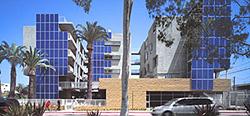 Prevailing breezes will cool the building, which will have no mechanical air conditioners. The U-shaped structure ‘acts like a giant wind scoop,’ said architect Larry Scarpa, a principal of Santa Monica-based Pugh & Scarpa.
Prevailing breezes will cool the building, which will have no mechanical air conditioners. The U-shaped structure ‘acts like a giant wind scoop,’ said architect Larry Scarpa, a principal of Santa Monica-based Pugh & Scarpa.
In yet another ‘green’ flourish, the building will collect all the rainwater from the alley behind the property and funnel it into a series of underground chambers. The water will slowly percolate back into the soil, which will filter the pollutants from the water while preventing contaminated water from spilling into Santa Monica Bay. The drainage system was paid for separately by the city of Santa Monica.
The concept of a building that would be energy self-sufficient emerged about two years ago, when Santa Monica officials met with members of the California Energy Coalition. The city’s Housing Division, which funds construction of low-income housing, chose to make a low-income housing project into a dream project of ‘green’ construction, and Colorado Court became the target.
‘We needed a demonstration project because a lot of developers feel that the technologies are unproven,’ Raida said.
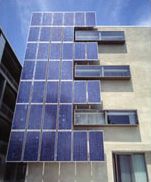 A number of apartment buildings in Santa Monica and Irvine are to be equipped with energy-saving technology by the Regional Energy Efficiency Initiative, but the Santa Monica building is the only project attempting to provide its own power as well.
A number of apartment buildings in Santa Monica and Irvine are to be equipped with energy-saving technology by the Regional Energy Efficiency Initiative, but the Santa Monica building is the only project attempting to provide its own power as well.
Rebates from the state Energy Commission helped defray the high cost of the energy-generating equipment. The state’s rebate on the solar panels, which cost about $225,000, will be about $62,000. The $57,000 micro-turbine and heat exchanger will yield a $15,000 rebate from Southern California Gas Co.
If recent research and development has yielded new ways of conserving energy and producing electricity, regulations and building codes have not kept pace.
In one instance, architects had to obtain special permission from the city to hang solar panels outside the exterior stairwells because building inspectors said the solar panels ‘enclosed’ the stairwells and triggered requirements for floors, ceilings and fire-rated walls.”
Santa Monica Mirror, December 6-12, 2000:
“[Architects] Pugh Scarpa Kodama and the Community Corporation have been working with the City of Santa Monica and Southern California Edison to come up with an ‘incentive-type’ plan, which would allot a certain amount of energy to each resident per month, and would award those who did not use the full amount with rebates on their energy bills....
Colorado Court’s units will rent for between $316 and $365. They will be available to low-income residents culled from the Community Corp’s waiting list, who meet the low-income requirements for this building. Twenty-two units will be rented to people making less than $12,775 yearly, another 22 to those making less than $14,600 yearly (these figures are based on 35 - 40% of the current median income of $36,500). According to Raida, the typical demographic for a building such as Colorado Court would include full time workers earning minimum wage, and people on fixed incomes such as retirees and the disabled.
The Community Corp’s waiting list currently numbers over 1,000 people.”
It’s great that the org’s and the city could pull together $5.8 million to build high-tech, green, low-income housing. But, experimenting on the poor for their demonstration project? Is this the flip side of environmental racism? Get some low-income tenants to live inside your the unproven technology? No air conditioning in Southern California? An experimental powerplant in the basement, and less-than-fire-rated exterior walls... that cover a fire exit? Evangelical indeed.
Dell: Recycling with Prison Labor
“The Computer TakeBack Campaign is protecting America’s public health by promoting corporate accountability for electronic waste.
Tens of million of computers become obsolete every year and less than 10% are collected for recycling, with the rest of them stored in homes and offices, disposed in landfills and burned in incinerators, and shipped to poor countries for dismantling under horrific conditions. Newer, faster, smaller, and cheaper products hit the market every day - all of them toxic, most of them designed for disposal rather than reuse and recycling, and, once obsolete, are ignored by the very companies that profit from short life-spans and cheap design.
Currently, the expense of collecting and managing discarded electronics is borne by taxpayer-funded government programs. Public policy and corporate practice have failed to promote producer take back and clean design. The principle of producer take-back shifts the burden for collection and recycling costs off of taxpayers and government to the producers, providing an incentive for companies to market products that are durable, less-toxic, and recyclable....
The Computer TakeBack Campaign was formed to promote clean design and brand owner responsibility for discarded computers and electronics.”
The campaign was launched on November 27, 2001 with the release of the Silicon Valley Toxics Coalition’s 3rd Annual Computer Report Card. The annual report measures the environmental qualities of electronic equipment and the environmental performance of companies. The report noted that several major U.S. computer companies ran TakeBack programs in Europe, but not in the United States.
Dell was singled out as the focus for the first major campaign. Dell has the largest share of the U.S. and global personal computer market, and are the leading seller of computers to institutions. The Computer TakeBack Campaign is also targeting Dell “because the company’s sales and distribution model uniquely positions it to establish an effective national take back system for used and discarded products.”
After a long campaign and a much public pressure, on March 19, 2003, Dell announced it’s new curbside recycling program. As of March 25, consumers in the continental U.S. could “order home pickup of unwanted notebooks, desktops, monitors, and other select computer equipment for $15 per unit.”
Dell, however, is using prison labor to do the dirty work of recycling its electronics.
A friend of laughingmeme writes:
- Dell still contracting with prison labor to do recycling... prison labor is a low-road solution which relies on ‘high tech chain gangs’ and thwarts the development of a legitimate recycling infrastructure... and prison laborers are handling toxic computers and OSHA standards are not enforced as they should be
- Dell still charging a fee at the back-end (instead of implicit in purchase price) for the pick-up, which is a disincentive for participation
- Dell not reporting on goals or setting timeframes/goals for recovery
- Dell not aggressively advertising program (they launched the program the week we went to war!)
- Dell not commenting/committing to phasing out the toxins in their products
- Dell partnering with a charity, but what will eventually happens to the computers? — they way they are designed now they all become obsolete at some point
- [As of mid-March] Dell has recovered only 1,000 machines in the last six months which is really pathetic. (they actually started taking back computers from consumers in sept, but are just now expanding the program to include home pick-up)
According to this fact sheet: prison labor is not protected by federal safety and health standards, nor is it covered by National Labor Relations Board policies. Financial support for this U.S. prison-industrial complex steals tax dollars from public education and environmental protection programs and kills private sector development in electronic recycling.
Prisoners should be able to develop occupational and educational skills, not forced to do dangerous, toxic work because companies can get away with it. Investing in prison labor also reinforces incarceration as a solution social, political, and economic problems.
Find out more, and what you can do.
Update: On July 3, 2003, Dell announced that it will stop using a vendor that relies on prison labor for its electronics recycling.
Call for Submissions: Share Your Vision
“Share Your Vision is a national art contest and exhibition, sponsored by Visual AIDS with funding from Roche. The Share Your Vision program was created to help raise awareness of the impact of cytomegalovirus (CMV) retinitis on the lives of people with HIV. CMV retinitis is an AIDS-related opportunistic infection, which, if left untreated, can lead to blindness. The contest is open to HIV-positive artists who have been affected by or touched by CMV retinitis. The most appropriate submissions will address, discuss or represent the artist’s understanding of and/or experience with CMV retinitis. Selected works will be displayed in an exhibition at Artists Space in New York and included in an accompanying exhibition catalogue....
The winning artwork may also be utilized by Roche, Visual AIDS or a designee of these parties for a public education campaign on CMV retinitis that may include a traveling exhibition. The artwork may be reproduced for use in the development of collateral materials (print, broadcast and/or Web) to support CMV awareness....
Each of the winning artists will be awarded a cash prize, and, for the top 13, a matching gift will also be donated to an HIV/AIDS charitable 501(c)(3) research or support organization of the winner’s choice.”
Yeah, so the big drug company hawk their pills and makes a profit off your work. It’s still an important and underexposed issue. And you get to put some of that marketing budget back into research or support.
Deadline for submissions is June 16, 2003. Check the Visual AIDS Web site for more info.


